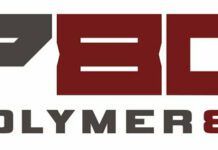The concept of a pocket pistol is as old as handguns. In the days of percussion, and even during the 200-odd years of flintlocks, many small handguns were made that were sort-of pocketable, if you had large pockets. Through the years technology got better, and though pockets got smaller, the concept of a hand-size pistol matured until today we find some remarkably tiny handguns with relatively outstanding power available.
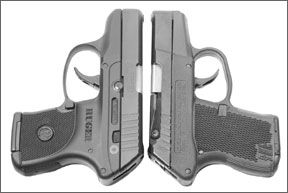
One of the very newest and hottest of these is the Ruger LCP, a 380 introduced to an eager crowd at the SHOT Show early in 2008. Reports are Ruger received well over 100,000 orders for the gun by the end of that weekend.
A gun that creates that much stir naturally interests the Gun Tests staff, and we obtained two of the very first issues of the LCP. Beginning on page 11, my colleague Roger Eckstine puts the LCP through its paces in the standard GT comparison format against guns from Walther USA and Taurus. For my part, I was curious about how the LCP would match up against the nearly identical Kel-Tec P3AT ($324), and I obtained a P3AT to investigate their similarities, differences, and relative worth.
For this head to head, I tested with Speer Gold-Dot 90-grain HPs, Magtech 95-grain FMJs, and Independence 90-grain FMJs.
My finding: The two guns are so nearly identical that the Ruger might have been a clone of the Kel-Tec. However, I still preferred one gun over the other, and to explain why, Ill discuss the common features first, and then take a look at each gun individually.
Design
The design features a polymer frame containing an aluminum subframe to which the mechanism is attached. It utilizes a steel slide with locked-breech barrel, and is double-action only. The guns have no safety lever. Neither gun stays open after the last shot, though the Ruger may be manually locked open. Both may be fired with the magazine removed. They are hammer-fired. Cycling the slide, as when chambering a round, moves the hammer about half-way back in its travel. A long, soft pull on the trigger then brings the hammer all the way back and drops it onto the spring-loaded firing pin. The hammer drops only once, after which the slide must be cycled to recock.
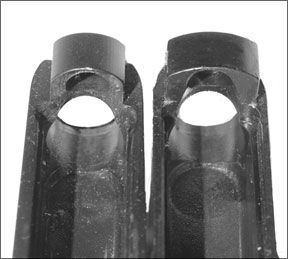
Both guns had a trigger movement of one inch, measured at the tip. The Italian-made magazines (one per gun) held six rounds. The Rugers mag had numbered witness holes on both sides; Kel-Tec, right-side holes, and no numbers. The mags were very easy to load. Both magazine releases were square buttons located on the left side of the frame. The Rugers was a touch larger and at a different height, so the magazines would not interchange.
The sights were pathetic on both guns. The integral front blade was wide enough, but stuck up on 0.030 inch above the surrounding metal. The rear notch was similarly shallow. This was clearly one of the compromises that made these guns so suitable for pocket carry. Theres nothing to catch on the clothing.
Both guns have six lands/grooves with right-hand twist. Takedown for the guns is identical. A small pin with a large head protrudes from the left side of the slide. With the gun unloaded, press the slide rearward slightly and lift out that pin using a small screwdriver or knife blade. Then ease the slide forward off the frame. The recoil spring and the barrel may then be removed for cleaning. Reassembly is similar, with only the need to press downward against the pin-retention spring while reinserting the pin. The Kel-Tec required slight movement of the barrel to align all the holes.
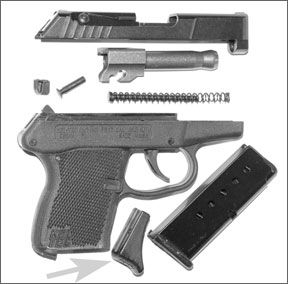
With both guns disassembled we tried interchanging parts. Very few of them did. The barrels would not, because of differences in the diameter of the muzzle ring. The slides did not We could put the Ruger slide with its barrel and recoil spring onto the Kel-Tec and lock it in place, but it looked like the slide ended up too far rearward. Closer inspection showed us the Rugers slide was an eighth-inch longer at the back. The Kel-Tec slide would not fit the Ruger because of a difference in frame design at the front. We thought the recoil springs would swap, and they did, but the Rugers two concentric springs were a quarter inch shorter than the Kel-Tecs. We made no attempt to shoot either gun with mismatched parts.
Now lets take a look at the differences.
Kel-Tec P3AT 380 ACP, $324
Besides our blued version, there are two other finishes available, Parkerized for $366 and hard-chromed at $382. Spare magazines cost $21.20. There are several accessories the owner of any of these might find useful, including an extra-round mag extension.
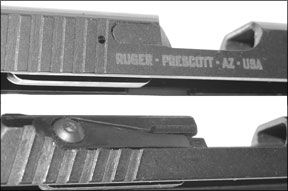
They also have a PPK-like magazine bottom, which we tried and liked. The company website (www.kel-tec-cnc.com) has details on these and a few more interesting items.The slide and barrel are made of SAE 4140 steel. The slide and frame of the P3AT had a relief formed into their sides, beginning at about the front of the trigger guard.
This removed metal from the slide that helped achieve the Kel-Tecs lighter weight. The frame had checkering molded into its grip panels, and vertical serrations at the front and back corners of the grip that we found useful in controlling the little gun in recoil. The most noticeable external difference between the two guns was the extractor spring on the Kel-Tec. This was external, and screwed to the right side of the slide in a large notch cut out for it. That notch also removed weight from the steel slide. While the exposed leaf spring put a lot of force onto the extractor, the hidden-plunger setup on the Ruger was several orders of magnitude stiffer, judging from the effort needed to move the extractor outward.
The detachable bottom of the magazine had the Kel-Tec name on it, and we noticed the entire grip frame was slightly narrower than that of the Ruger. The very bottom of the frame had a notch that contained a cross pin that in turn retained the bottom of the hammer spring, the loop of which was visible. (The hammer spring works in tension, not compression.) These items were concealed on the Ruger.
The tip of the trigger came to a rather sharp edge, which we found to be painful on the trigger finger during the shooting tests. Here and there on the Kel-Tec we found tiny bits of flashing or burrs on the polymer. A few minutes with a sharp knife would get rid of them. These were entirely absent from the Ruger.
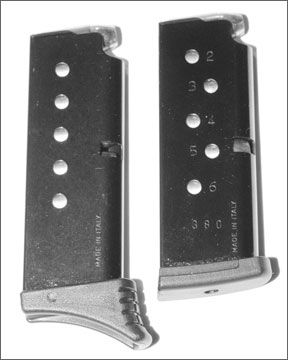
The Kel-Tec P3ATs manual warned us that one part, the ejector, could fall out of the frame with the gun taken down. It did, and we noted its very easy to lose that part. The same is true of the main takedown pin. Lose either of those small parts and you have no gun to shoot.
Inside the slide the Kel-Tec had a large hole surrounding the zone where the hammer strikes the firing pin. This also removed significant weight. Another difference was at the front of the slides, where the Kel-Tec had a wider lip around the recoil-spring hole. Kel-Tec gives a nominal trigger pull weight of 5 pounds at the company website (www.kel-tec-cnc.com). Ours measured 8.3 pounds.
On the range, our first shot resulted in a loud “Ouch!” Our trigger-fingers nail was driven into the thumb, or vice versa, from the force of recoil. We had shot the Ruger first, and that had not happened with the LCP. Apparently the extra weight of the Ruger prevented this contact. A slight grip readjustment fixed that problem, but another persisted. That sharp bottom edge of the trigger kept abrading our trigger finger. This was the only lasting discomfort we had with the Kel-Tec, and wed take a file to that trigger tip immediately if we owned the gun. Recoil was noticeable, even pronounced, with the hot Speer Gold Dot ammo, but a very firm grip kept the gun under control. We tried the optional-accessory bottom extension for the magazine. This $6.65 “P3AT Grip Extension” gave more room for our third finger, much like the PPK magazine extension. We found it to be a valuable aid to control. Groups got smaller because the gun didnt shift in the hand as much. The extension also fit the Ruger, as well discuss below.
Accuracy of the Kel-Tec with Magtech ammo was not great, though we thought it adequate. The best we did was ten into a group 9
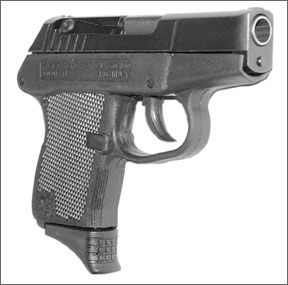
inches high by 3.5 inches wide at 15 yards. Switching to Speer Gold Dot and then to the Independence, things picked up. Groups were as good the Rugers. Our Kel-Tec groups got smaller during our testing, and by the end they were all equal to the Rugers. The sights were well enough matched to impact point on both guns, and best with the hot Speer. Rapid fire did not cause any problems with trigger resetting, as we reported recently for a Kel-Tec in a different caliber. The only complaints we had were about the sharp trigger and the lousy sights. Fast shooting tended to give us high hits until we realized we were raising the front of the gun to find the front sight. There were no failures to feed, fire, or function whatsoever during our sessions with the Kel-Tec. We liked the gun, and believe it does a job that no other gun can do as well.
Ruger LCP No. 3701 380 ACP, $330
Our test gun is the only version of the LCP available at this time. Spare magazines cost $27, and Ruger doesnt offer a finger extension. The gun comes with a soft, zippered pouch.
Ruger has basically refined the Kel-Tec, in our view. The checkering on the slightly wider grip frame is finer-too fine, we thought. The Ruger jumped around in the hand more than the Kel-Tec because
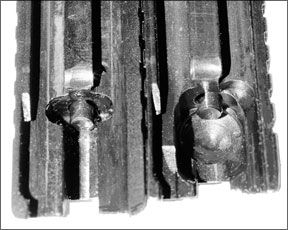
of that finer checkering. The LCPs frame had molded-in grooves for the thumb and trigger finger. There was a small panel of checkering on the back strap, and some useless horizontal serrations on the front strap that were not sharp enough to bite and hold our fingers in place. The gun slid vertically in our hands every shot. We thought the sharpened corners of the Kel-Tec were more useful. We wanted more traction on the Ruger. Ideally wed like a combination of the Kel-Tecs sharp, vertical serrations on the corners to keep the gun from twisting, coarse checkering on the front and back of the grip strap, and the Kel-Tecs coarse checkering on the grip panels. These tiny guns tend to twist and jump about, especially with the sharp-recoiling Speer Gold Dot HP ammo, and need all the “glue” the makers can provide. It took a strong pair of hands to keep the guns well under control during rapid fire.
Rugers execution of the entire gun was well done, we thought, despite our suggested improvements. The plastic was smooth and blemish free. The front of the frame tucked neatly inward under the muzzle. The slide was pleasantly smoothed off everywhere and had excellent matte bluing. The trigger pull was lighter at 7.2 pounds vs. 8.3 for the other, and the trigger was comfortable. There was more room for the finger between the trigger and the front strap than on the other gun. We also found the stacking of the Rugers trigger to be easier to control in slow fire.
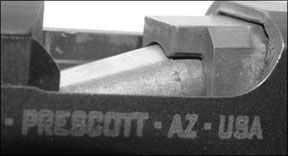
On the range we found the Ruger could put ten from a steady rest into less than four inches all day at 15 yards. It did that with all three types of ammo. However, as our hands got tired the groups tended to enlarge, and the gun jumped around too much because of its lack of traction. On a whim we borrowed the magazine extension from the Kel-Tec. This didnt quite fit right against the LCPs frame, but it worked well enough to shrink the Rugers groups back to around 2 inches or less, and we got much less movement of the gun with each shot. We thought the grip extension made either gun less suitable for pocket carry, but much easier to control. We suggest Ruger make such an extension available asap.
Unfortunately, we had a persistent problem with the Ruger LCP in the form of failures to feed. This happened with all three types of ammunition, and usually right after the third shot from a full magazine. The incoming round stuck between the top of the chamber and the breech face. Clearing it could be accomplished by either pressing forward on the slide or withdrawing the magazine. We expected the problem to go away with more shooting, but it stayed with us. Cleaning the gun didnt help. On close inspection
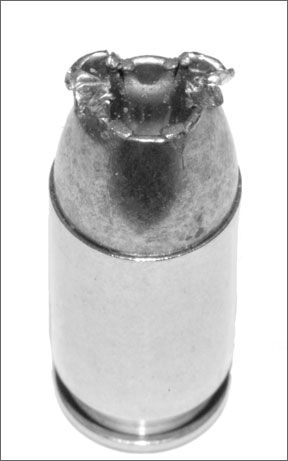
we found rough surfaces on the breech face and inside the top extension of the chamber. We did some hasty polishing there, and for the duration of our testing there were no more failures to feed with the round-nose ammunition. But we had a gross failure to feed of a different nature with Speer Gold Dot that was not related to our polishing. The hollow nose of the bullet jammed into the base of the feed ramp, greatly distorting the bullet nose and creating a stoppage that was difficult and time-consuming to clear. This once again warned us that all self-defense ammunition must be tested before trusting your life to it.
Conclusions
Its a rare gun test when we can fit two handguns into one coat pocket. But when we lost one of them in our pocket, we knew these were indeed small and very light handguns. The Ruger weighed 9.5 ounces, and the Kel-Tec weighed 8.8. We liked the concept of these small 380s very much, though we thought both guns needed some attention before wed consider them ready for the street. The Kel-Tec definitely needed some file work on its trigger nose. The Ruger needed internal deburring and a touch of polishing. Both guns would benefit from sights twice as high as they now are, though thats not necessary.
Everyone who handled the two guns preferred the coarser checkering of the Kel-Tec, though the Rugers looked nicer. If theres a better 380 concealment handgun than the P3AT, we would like to know what it is. These guns are both great, but I narrowly preferred the Kel-Tec.
–By Ray Ordorica




























